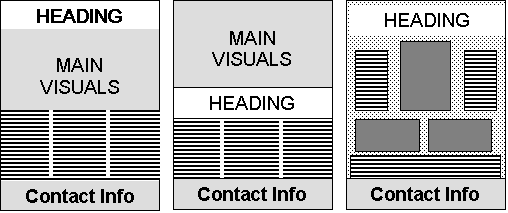A successful poster will attract the reader’s interest, summarize the information and encourage discussion. To be effective, it needs to be visually dynamic and hold the attention of your reader long enough to communicate your message. The main advantage of a poster is that it is available for extended periods of time, allowing readers to browse through the materials at their own pace and revisit the display. It also frees the presenter to discuss details of the poster and answer questions.
There are several limitations of a poster display, including the physical restrictions of space, which limit the poster’s length and width. Also, there may be a number of posters presented at the same time, each competing for the viewer’s attention. As the poster’s message becomes familiar, it loses its ability to catch and hold the attention of the reader.
You will have the best chance of attracting the interest of your audience if:
- The lettering is large enough to be legible
- The display is attractive and has a professional finish
- The content is well structured and easy to follow
Points to consider when creating a poster
- Most people skim a poster, looking at the title and pictures first. They might read the rest of the poster if they think the material is interesting.
- The relationship between text and graphics is important. Place the text so the reader can view it systematically.
- Posters incorporate a visual combination of images, lines, color, and words. The basic elements of a poster are the main heading, supporting text and visuals.
- The main heading should be brief, to the point, and capture interest. Use a simple font from 140 to 200 point sizes (about 2 inches high). For maximum legibility, use capitals with lowercase lettering.
- Visuals are the focal point of a poster. Photographs, illustrations, diagrams, and charts can all present the same information in different ways. Labels must be close to any diagrams.
- Selective use of color enhances a poster. Colored borders, bullets, and blocks draw attention to specific details.
- If the poster is to be used a number of times, it can be laminated in clear plastic for protection.
- Research posters are meant to be a synopsis of your work. Try to limit your text to the most important points.
- While the layout and design of the poster are up to you, the first element (header) in your display should contain the title of your project, a list of all project collaborators, and an abstract.
- Where appropriate, acknowledge the funding agency (this can be added at the bottom).
Design checklist
Have you…
- Proofed the content for spelling and/or grammatical errors?
- Used visuals wherever possible to illustrate ideas?
- Presented a single concept with each visual?
- Broken down complex visuals into simpler ones?
- Chosen visuals because they add information?
- Eliminated distracting backgrounds?
- Avoided centering every element on the display?
- Used graphs to present data?
- Used bold, plain typefaces for headings?
- Avoided using more than two different typefaces?
- Used italics, bold, underlining or color for emphasis?
- Used capitals and lowercase lettering?
- Used the brightest and lightest color to focus attention on important elements?
- Used lettering and visuals that contrast with background color?
- Used consistent background colors in a series of posters?
- Limited the number of colors on each poster?
- Made the design as simple as possible?
- Made sure your elements appear balanced?
- Made sure it is legible. If the audience can’t read it, don’t use it.
Technical aspects of poster design
General Information
- PowerPoint is the recommended software for poster design. Then, convert the file to a PDF for printing.
- Open a blank presentation and set the slide size to the desired finished product. Paper size limits one dimension to either 36” or 42”, so set the other dimension to the necessary size (e.g., 48”x42”, 48”x36”, 56”x42”, etc.). You can use smaller dimensions then increase the print size to 200%, but you will probably lose resolution and quality.
- Use a 2” margin; 1” is the minimum margin, but you may run into format/printing problems.
- If you make changes to your file before printing, save the file under a different name. Always preserve your original file in case you need to revert to it. Keep a backup copy of the file stored on another disk and/or hard drive.
Graphs
- Imported graphs cannot be edited in PowerPoint. Be sure that the graph is correct before importing.
- Graph titles and axis titles cannot be resized once imported into PowerPoint. If you need to make corrections, use the original graphics program to edit the figure and then import the revised graph.
Pictures
- Scanning resolution should be between 150 and 300 dpi. Lower resolutions will result in poor quality images, particularly when printed. Higher resolutions do not produce noticeably better images but they will increase the PowerPoint file size and may make it more difficult to manage.
- Pictures must be sized prior to importing into PowerPoint. Once in PowerPoint, resizing pictures may result in a visually acceptable format but it will print in the original, uncropped proportions.
- Do not enlarge a graphic beyond its original size or it will pixelate which detracts from the quality of the poster.
- Do not place text boxes, graphics, etc. over the slide edge.
Sample layouts

This information was adapted from the website, “Creating Effective Posters Presentations.”

